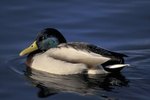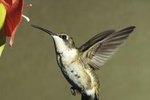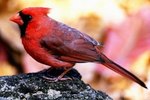It's all in the quack. In other words, other than vent sexing, listening to a duck's quack is the most precise method of determining a duck's gender, especially for young ducks and duck species with similar looking males and females. There are additional methods of determining the sex of ducks, but they are not as reliable.
Listen to the Quack
The typical quack sound associated with ducks is only made by female ducks. Both male and female ducks start out making peeping noises, but females generally add a quack to their repertoire of noises by 4 to 6 weeks old. By 8 weeks, a male duck's peeps become monotone and raspy. At 10 weeks, male and female duck voices should be clearly distinguishable, with the female quacking loudly, and the male quietly peeping in a deep monotone.
Vent Sexing
Vent sexing is accomplished by looking into the cavity, called the cloaca, which houses a duck's genitalia. It is done by holding a duckling on its back, exposing the cloaca and pressing in between a duck's legs to open it. It is easier to see a female's cone-shaped organ than a male's smaller, longer pointed organ. Additionally, it may take several seconds after opening a male's cloaca for his organ to appear. Vent sexing can be done when a duckling is around 12 days old.
Warnings
To avoid injuring a duckling, and to ensure an accurate result, is best to have someone with experience do it.
Curly Tail Feathers
At approximately 2 to 3 months of age, one or two tail feathers on male ducks will curl up toward his back. These are known as drake feathers. However, observing a curled tail is not a reliable method of determining a duck's gender for a couple of reasons. Male ducks molt once a year, so you won't see any drake feathers until new ones grow in, and when there are no males in a flock, a female duck occasionally will have a curly tail feather.
Freckled Bills
Some female ducks develop spots on their bills that resemble freckles. This occurs with hens who have been laying eggs for awhile, and is due to the egg yolk's absorption of a yellow colored pigment from duck feed. This pigment is what gives a duck's bill its yellow color. When the yolk absorbs the pigment, the yellow on a hen's bill can fade to reveal spots of melanin pigment. The problem with determining gender by freckles is that not all females develop them, so a duck without freckles could be a female or a male.
Color and Size
Around 3 months of age, adult feathers begin to sprout. This is when the color differences between males and females of sexually dimorphic species become apparent. Some examples of these species include mallards, wood ducks, mountain ducks, blue-winged shovelers and chestnut teals. In general, male ducks have more colorful plumage than females to attract females for mating purposes. Male ducks are also slightly larger than females and have heavier heads and necks. For duck species that aren't sexually dimorphic, such as gray teals, pink-eared ducks and Pacific black ducks, the only reliable way to tell a male and female apart is through vent sexing or listening for the female's quack.
References
Writer Bio
Laura Payne has been freelance writing for several online publications in her free time since 2006. She holds a Master of Arts in linguistics from Wayne State University and a Bachelor of Arts in journalism from Oakland University. Payne teaches linguistics classes at both universities on an adjunct basis.




